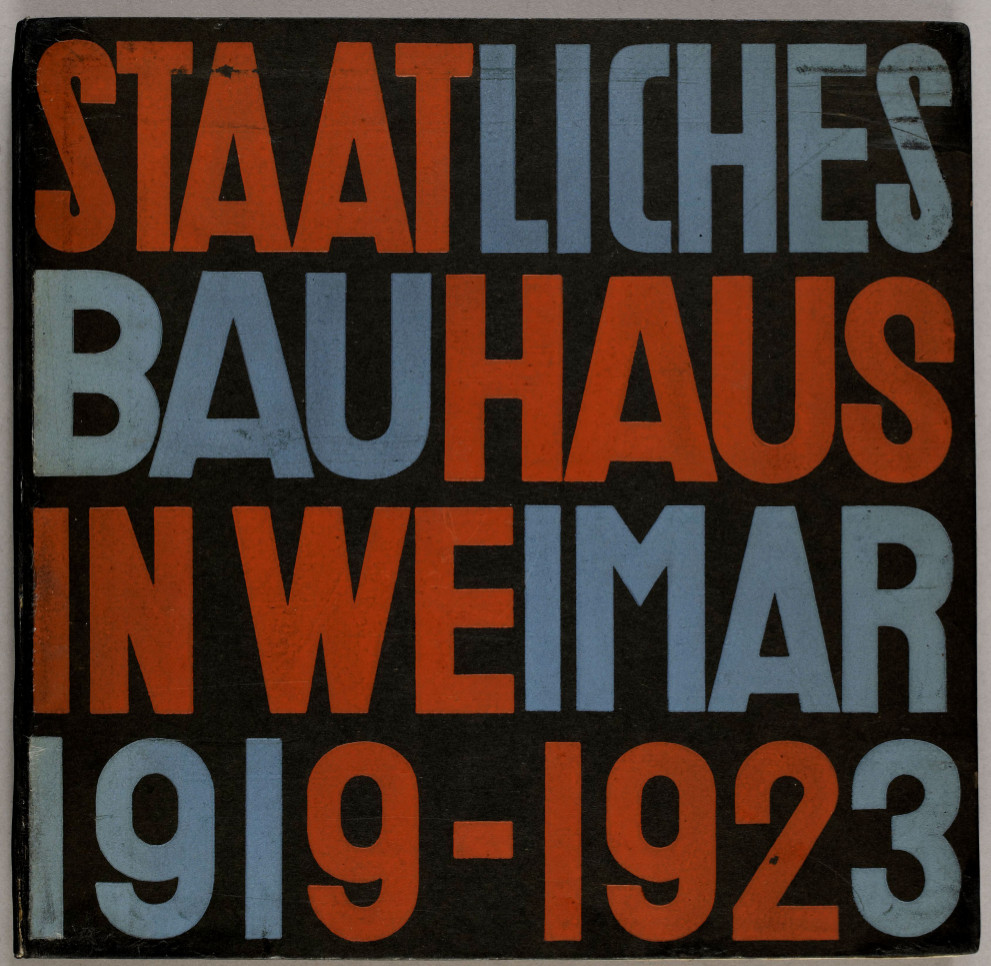Staatliches Bauhaus Weimar, 1919-1923 (1923) [German]
Filed under book | Tags: · architecture, art, art education, bauhaus, dance, design, drawing, education, film, painting, photography, sculpture, theatre, typography, weimar republic

This work was published on the occasion of the major Bauhaus exhibition in August and September 1923 in 2,000 copies (another 300 were printed in English and 300 in Russian). The colour plates include nine original lithographs by Herbert Bayer, Marcel Breuer, L. Hirschfeld-Mack (2), R. Paris, P. Keler and W. Molar, K. Schmidt (2), and F. Schleifer. The texts are by Walter Gropius, Lyonel Feininger, Paul Klee, Gertrud Grunow, Wassily Kandinsky, László Moholy-Nagy, Oskar Schlemmer, Johannes Itten, Georg Muche, Lothar Schreyer, Gerhard Marcks, Adolf Meyer and others.
Publisher Bauhausverlag, Weimar and Munich, 1923
Typography L. Moholy-Nagy
Cover design Herbert Mayer
Print F. Bruckmann, Munich (texts), V. Lübecke, Erfurt (printing blocks for the 4-color prints), and Dietsch & Brückner, Weimar (colour plates)
225 pages, 20 colour plates, 147 halftone ills., 25 × 26 cm
via Bibliothèque Kandinsky
PDF (325 MB, updated on 2018-3-6)
See also Bauhaus publications on Monoskop wiki.
Walter Gropius, L. Moholy-Nagy (eds.): Bauhaus Books, 10 vols. (1925–1930) [German]
Filed under book | Tags: · architecture, art, art education, bauhaus, dance, design, drawing, education, film, montage, painting, photography, sculpture, theatre

1. Walter Gropius, Internationale Architektur, 1925, 111 pp.
2. Paul Klee, Pädagogisches Skizzenbuch, 1925, 50 pp.
4. Die Bühne am Bauhaus, 1925, 84 pp.
7. Walter Gropius (ed.), Neue Arbeiten der Bauhauswerkstäffen, 1925, 115 pp.
8. L. Moholy-Nagy, Malerei, Fotografie, Film, 1925/27, 140 pp.
9. Kandinsky, Punkt und Linie zu Fläche: Beitrag zur Analyse der malerischen Elemente, 1926, 190 pp.
10. J.J.P. Oud, Holländische Architektur, 1929, 107 pp.
11. Kasimir Malewitsch, Die gegenstandslose Welt, 1927, 104 pp.
12. Walter Gropius, Bauhausbauten Dessau, 1930, 221 pp.
14. László Moholy-Nagy, Von Material zur Architektur, 1929, 241 pp.
Publisher Albert Langen, Munich, 1925-1930
via Bibliothèque Kandinsky
Download all 10 volumes through Monoskop wiki
Comment (0)Matthew Wisnioski: Engineers for Change: Competing Visions of Technology in 1960s America (2012)
Filed under book | Tags: · 1960s, 1970s, activism, computing, education, engineering, history of computing, history of technology, labour, luddism, military, science, space, technology

“In the late 1960s an eclectic group of engineers joined the antiwar and civil rights activists of the time in agitating for change. The engineers were fighting to remake their profession, challenging their fellow engineers to embrace a more humane vision of technology. In Engineers for Change, Matthew Wisnioski offers an account of this conflict within engineering, linking it to deep-seated assumptions about technology and American life.
The postwar period in America saw a near-utopian belief in technology’s beneficence. Beginning in the mid-1960s, however, society—influenced by the antitechnology writings of such thinkers as Jacques Ellul and Lewis Mumford—began to view technology in a more negative light. Engineers themselves were seen as conformist organization men propping up the military-industrial complex. A dissident minority of engineers offered critiques of their profession that appropriated concepts from technology’s critics. These dissidents were criticized in turn by conservatives who regarded them as countercultural Luddites. And yet, as Wisnioski shows, the radical minority spurred the professional elite to promote a new understanding of technology as a rapidly accelerating force that our institutions are ill-equipped to handle. The negative consequences of technology spring from its very nature—and not from engineering’s failures. “Sociotechnologists” were recruited to help society adjust to its technology. Wisnioski argues that in responding to the challenges posed by critics within their profession, engineers in the 1960s helped shape our dominant contemporary understanding of technological change as the driver of history.”
Publisher MIT Press, 2012
ISBN 0262018268, 9780262018265
296 pages
via a2
Interview with the author (Carla Nappi, New Books in Science, Technology, and Society, audio, 1h)
Review (Caroll Pursell, The American Historical Review, 2014)
Review (Kevin T. Baker, The Sixties, 2013)
Review (Stephen H. Unger, 2013)

